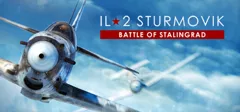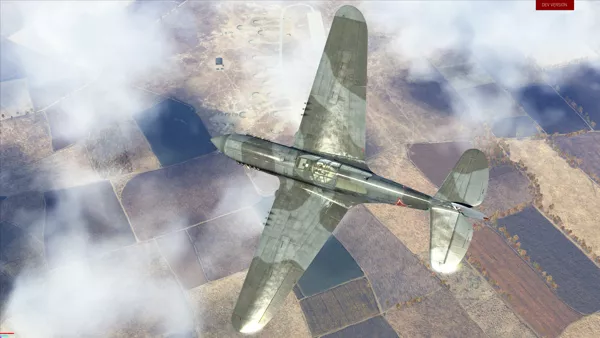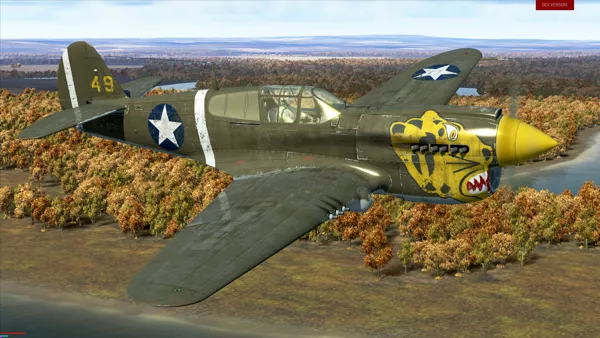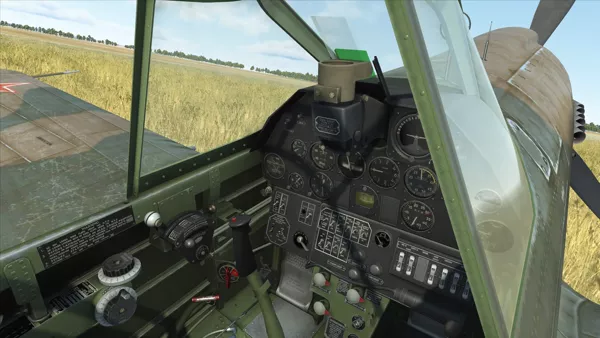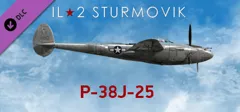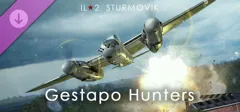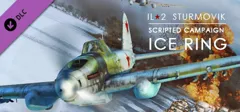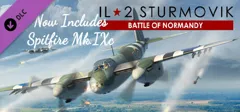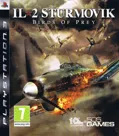IL-2 Sturmovik: Curtiss P-40E-1 Kittyhawk
Official Description (Ad Blurb)
Fly the legendary P-40E! It was called the Kittyhawk by the Soviets and the British, but the Americans dubbed it the Warhawk. Regardless of the name, the P-40 was the most mass-produced fighter by the US during WWII with many being used by the Soviet Union under the Lend-Lease Act.
The P-40 puts up a tough fight and is interesting to fly. It's particularly notable for its powerful armament of six .50 cal. machine guns. An enemy fighter won't last long against the P40’s massive firepower.
The P-40's dimensions are much larger when compared to German and Soviet fighter planes. It gives the pilot some extra room and provides for more armored protection for its pilot. However, its size makes it bigger target. Stay vigilant and check your six often!
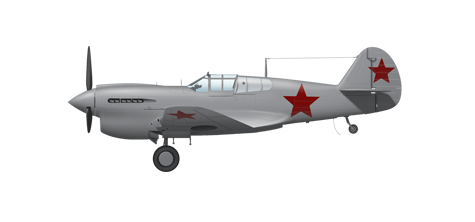
- Armament: 6 x wing-mounted Browning M2 .50 cal. (12.7mm) machine guns with 235 rounds per gun and a rate of fire of 850 rounds per minute.
- Length: 9.05 m (29.7 ft.)
- Wingspan: 11.4 m (37.4 ft.)
- Wing surface: 21.92 sq. m (71.9 sq. ft.)
Modifications
- Removal of two (2) wing-mounted machine guns to reduce total weight (156 kg / 344 lbs. weight savings, minor speed gain)
- Additional M2 .50 cal. MG ammo instead of 235 rounds per gun. (312 for inner guns, 291 for middle guns, 240 for outer guns or 615 per gun when equipped with just four guns. ( 207 kg / 456 lbs. weight increase, minor speed loss)
- 4 x ROS-82 (82 mm) High Explosive unguided rockets. (40 kg / 88 lbs. weight increase, additional drag results in 10-13 kph speed loss)
- 1 x FAB-250sv (254 kg) General Purpose Bomb. (264 kg / 582 lbs. weight increase with bomb rack, 19 kph / 31 mph speed loss, 7 kph / 11 mph speed loss after drop)
- 1 x FAB-500M (522 kg) General Purpose Bomb (532 kg / 1173 lbs. weight increase with bomb rack, 36 kph / 22 mph speed loss, 7 kph / 4 mph speed loss after drop)
Skins
- Standard pattern with winter camo
- 191 IAP VVS KBF, Baltic, 1943 ('56' standard British two-color pattern with white spinner and rudder)
- No.112 Sqn. flown by Sgt Henry Burney and Sqn. Ldr. Clive Caldwell, Libya, March-May 1942 ('GA-Y' standard British two-color desert pattern with shark mouth)
- Late style VVS camo pattern, dark grey and grey with white rudder and stars.
- Default USAAF dark olive drab overall overpainted with winter camo
- 1st. American Volunteers Group 'Flying Tigers', China, 1942 ('77' standard British two-color pattern with Chinese markings and Flying Tigers emblems)
- No.14 Sqn. Royal Canadian Air Force, Western Air Command ('Z' standard British two-color pattern with shark mouth)
- 11th FS USAAF, Capt. John S. Chennault, Umnak, Aleutian Islands, Summer 1942 ('49' default USAAF dark olive drab with tiger head)
- 154th IAP, Maj. P.A. Pokryshev, Leningrad area, 1942 ('50' standard British two-color pattern with white spinner and kill markings)
- 325th FG, CO Lt. Col Robert Baseler, Mateur, Tunisia, September 1943 (dark grey with checkered tail, red ace of spades on nose and red ailerons)
Flight Parameters
Indicated Stall Speed in Flight Configuration: 153 -176 kph (95 – 109 mph)
Indicated Stall Speed in Takeoff / Landing Configuration: 141 -164 kph (87 – 102 mph)
Dive Speed Limit: 860 kph (534 mph)
Maximum Load Factor: 12.2 G
Stall Angle of Attack in Flight Configuration: 14 °
Stall Angle of Attack in Landing Configuration: 12.6 °
Ground Speed at Sea Level, Engine Mode - Take-off: 494 kph (307 mph)
Maximum Ground Speed at 5000 m (16404 ft.), Engine Mode - Take-off: 601 kph (373 mph)
Service Ceiling: 9200 m (30,183 ft.)
Climb Rate at Sea Level: 12.5 m/s (41 ft. p/s)
Climb Rate at 3000 m (9842 ft.): 10 m/s (33 ft. p/s)
Climb Rate at 6000 m (19685 ft.): 3.7 m/s (12 ft. p/s)
Maximum Performance Turn at Sea Level: 24.3 s, at 270 kph (168 mph) IAS.
Maximum Performance Turn at 3000 m (9842 ft.): 36.1 s, at 270 kph (168 mph) IAS.
Flight Endurance at 3000 m (9842 ft.): 2.8 hrs. at 350 kph (217 mph) IAS.
Takeoff Speed: 160 - 190 kph (99 - 118 mph)
Glideslope Speed: 210 - 220 kph (130 - 138 mph)
Landing Speed: 140 -145 kph (87 – 90 mph)
Landing Angle: 13.9 °
Note 1: Data provided is for international standard atmosphere (ISA).
Note 2: Flight performance ranges are given for possible aircraft weight ranges.
Note 3: Maximum speeds, climb rates and turn times are given for standard aircraft weight.
Note 4: Climb rates are given for Take-off power, turn times are given for Maximum possible power.
Engine:
Model: V-1710-39
Maximum Power in Maximum Possible Power Mode at Sea Level: 1470 HP
Maximum Power in Take-off Mode at Sea Level: 1150 HP
Maximum Power in Nominal Mode at Sea Level: 900 HP
Maximum Power in Combat Mode at 12000 feet (3657 m): 1150 HP
Maximum Power in Nominal Mode at 10800 feet (3291 m): 1000 HP
Engine Limits:
Nominal (unlimited time): 2600 RPM, 37.2 inch Hg
Combat Power (up to 5 minutes): 3000 RPM, 42 inch Hg
Take-off Power (up to 5 minutes): 3000 RPM, 45.5 inch Hg
Maximum Possible Power (prohibited by flight manual): 3000 RPM, 56.0 inch Hg
Water Rated Temperature in Engine Output: 105 - 115 °C (221 – 239 °F)
Water Maximum Temperature in Engine Output: 125 °C (257 °F)
Oil Rated Temperature in Engine Intake: 70 - 85 °C (158 – 185 °F)
Oil Maximum Temperature in Engine Intake: 90 °C (194 °F)
Supercharger Gear Shift Altitude: N/A Single Gear
Empty Weight: 3073 kg (6775 lbs.)
Minimum Weight (no ammo, 10% fuel): 3264.2 kg (7196 lbs.)
Standard Weight: 3819.1 kg (8420 lbs.)
Maximum Takeoff Weight: 4414 kg (9371 lbs.)
Fuel Load: 404 kg / 561 l (891 lbs. / 148 gal.)
Maximum Combat Load: 1341 kg (2956 lbs.)
Combat Debut: December 1941
Source: Steam Store Description
Groups +
Promos
Analytics
Identifiers +
Contribute
Are you familiar with this game? Help document and preserve this entry in video game history! If your contribution is approved, you will earn points and be credited as a contributor.
Contributors to this Entry
Game added by Charly2.0.
Game added July 26, 2017. Last modified March 17, 2025.



